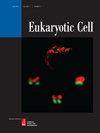Lipid Biosynthetic Genes Affect Candida albicans Extracellular Vesicle Morphology, Cargo, and Immunostimulatory Properties.
引用次数: 60
Abstract
ABSTRACT Microbial secretion is integral for regulating cell homeostasis as well as releasing virulence factors during infection. The genes encoding phosphatidylserine synthase (CHO1) and phosphatidylserine decarboxylase (PSD1 and PSD2) are Candida albicans genes involved in phospholipid biosynthesis, and mutations in these genes affect mitochondrial function, cell wall thickness, and virulence in mice. We tested the roles of these genes in several agar-based secretion assays and observed that the cho1Δ/Δ and psd1Δ/Δ psd2Δ/Δ strains manifested less protease and phospholipase activity. Since extracellular vesicles (EVs) are surrounded by a lipid membrane, we investigated the effects of these mutations on EV structure, composition, and biological activity. The cho1Δ/Δ mutant releases EVs comparable in size to wild-type EVs, but EVs from the psd1Δ/Δ psd2Δ/Δ strain are much larger than those from the wild type, including a population of >100-nm EVs not observed in the EVs from the wild type. Proteomic analysis revealed that EVs from both mutants had a significantly different protein cargo than that of EVs from the wild type. EVs were tested for their ability to activate NF-κB in bone marrow-derived macrophage cells. While wild-type and psd1Δ/Δ psd2Δ/Δ mutant-derived EVs activated NF-κB, the cho1Δ/Δ mutant-derived EV did not. These studies indicate that the presence and absence of these C. albicans genes have qualitative and quantitative effects on EV size, composition, and immunostimulatory phenotypes that highlight a complex interplay between lipid metabolism and vesicle production.脂质生物合成基因影响白色念珠菌胞外囊泡形态、货物和免疫刺激特性。
在感染过程中,微生物分泌是调节细胞稳态和释放毒力因子的必要条件。编码磷脂酰丝氨酸合成酶(CHO1)和磷脂酰丝氨酸脱羧酶(PSD1和PSD2)的基因是白色念珠菌参与磷脂生物合成的基因,这些基因的突变会影响小鼠线粒体功能、细胞壁厚度和毒力。我们在几个琼脂分泌实验中测试了这些基因的作用,发现cho1Δ/Δ和psd1Δ/Δ psd2Δ/Δ菌株的蛋白酶和磷脂酶活性较低。由于细胞外囊泡(EVs)被脂质膜包围,我们研究了这些突变对EVs结构、组成和生物活性的影响。cho1Δ/Δ突变株释放的ev大小与野生型ev相当,但psd1Δ/Δ psd2Δ/Δ株的ev比野生型的ev大得多,其中包括野生型ev中未观察到的>100 nm ev群体。蛋白质组学分析显示,这两个突变体的ev蛋白含量与野生型的ev蛋白含量有显著差异。在骨髓源性巨噬细胞中检测ev激活NF-κB的能力。野生型和psd1Δ/Δ psd2Δ/Δ突变体衍生的EV活化NF-κB,而cho1Δ/Δ突变体衍生的EV则没有。这些研究表明,这些白色念珠菌基因的存在和缺失对EV大小、组成和免疫刺激表型具有定性和定量影响,这突出了脂质代谢和囊泡产生之间的复杂相互作用。
本文章由计算机程序翻译,如有差异,请以英文原文为准。
求助全文
约1分钟内获得全文
求助全文
来源期刊

Eukaryotic Cell
生物-微生物学
自引率
0.00%
发文量
0
审稿时长
1 months
期刊介绍:
Eukaryotic Cell (EC) focuses on eukaryotic microbiology and presents reports of basic research on simple eukaryotic microorganisms, such as yeasts, fungi, algae, protozoa, and social amoebae. The journal also covers viruses of these organisms and their organelles and their interactions with other living systems, where the focus is on the eukaryotic cell. Topics include: - Basic biology - Molecular and cellular biology - Mechanisms, and control, of developmental pathways - Structure and form inherent in basic biological processes - Cellular architecture - Metabolic physiology - Comparative genomics, biochemistry, and evolution - Population dynamics - Ecology
 求助内容:
求助内容: 应助结果提醒方式:
应助结果提醒方式:


